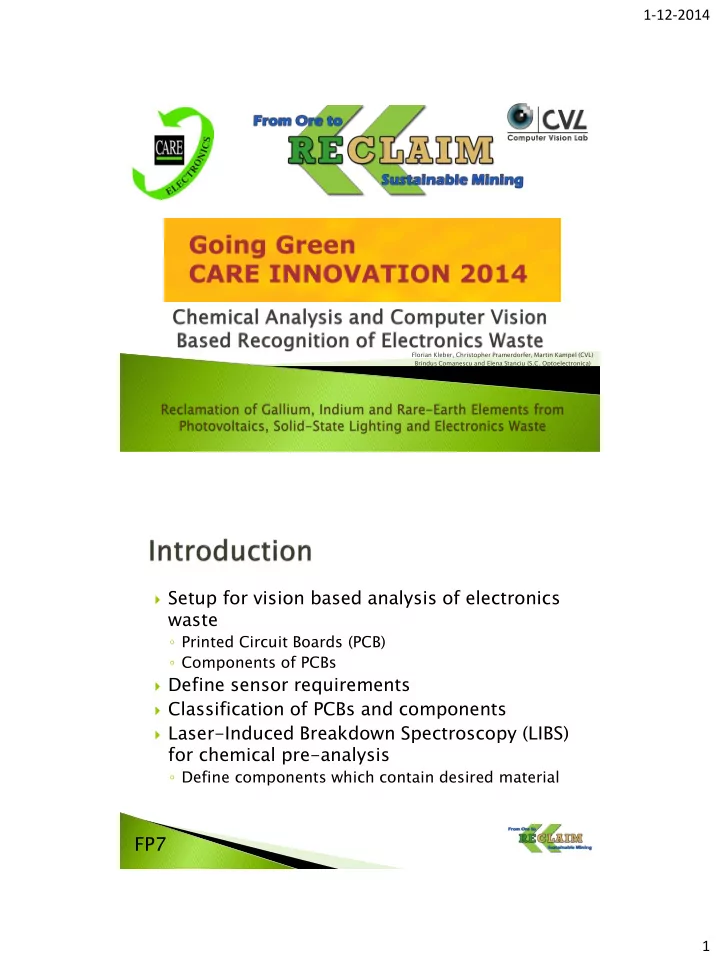

1-12-2014 Florian Kleber, Christopher Pramerdorfer, Martin Kampel (CVL) Brindus Comanescu and Elena Stanciu (S.C. Optoelectronica) Setup for vision based analysis of electronics waste ◦ Printed Circuit Boards (PCB) ◦ Components of PCBs Define sensor requirements Classification of PCBs and components Laser-Induced Breakdown Spectroscopy (LIBS) for chemical pre-analysis ◦ Define components which contain desired material FP7 1
1-12-2014 Sensors ◦ DSLR camera (Nikon D4, 16.2 MP, 60 mm focal length) ◦ IP camera (Axis P1346, up to 1080 P, 30 fps) ◦ 3D sensor (Asus Xtion PRO Live) ◦ MS camera (Hamamatsu C9300-124, 10 MP, 300-1000nm) ◦ TOF (Bluetechnix M100) Evaluation of different optical sensors necessary to -) determine what sensors are suitable for recognition -) identify strengths, weaknesses, and complementary effects FP7 Bicolor LEDs with configurable color temp Heureka LED with 11 different wavelengths FP7 2
1-12-2014 Polarization filters for lights and sensors Filter specular reflections Achieve uniform illumination FP7 High resolution (spatial and radiometric) Images vary depending on wavelength ◦ Readability of labels, visibility of PCB traces Limited frame rate (up to 2 fps) Suitable for detailed analysis ◦ Resolution similar to Nikon, but less noise ◦ Wider sensitivity range increases flexibility (UV, IR) Ibrahim et al. 2009 FP7 3
1-12-2014 Caption of one IC at all different wavelengths (same position) Label of QFP elements at VIS (first row) and Amber, 570 nm (second row) Influence of the incident angle of the light is illustrated Printed circuits at VIS and IR (870 nm) FP7 Evaluation of Asus Xtion Pro Live and Bluetechnix TOF sensors Advantages: object geometry available, invariant to illumination Disadvantages: low resolution, specular surfaces not reliably measurable Combination of multiple frames and interpolation of missing data mandatory ◦ Asus Xtion Pro Live superior to TOF (higher resolution, less noise) Combination FP7 4
1-12-2014 FP7 Professional DSLR camera IP camera 16.2 MP resolution (4928x3280) Up to 1080p resolution Lens with 60mm focal length at 30fps 12 or 14 bit depth in RAW mode FP7 5
1-12-2014 Identification of PCBs via comparison to database ◦ Comparison using both geometry and appearance Identifying PCBs allows for ◦ Determining whether they contain valuable SMDs ◦ Knowing what SMDs they contain and Feature Extraction where they are located ◦ An individual treatment of PCBs for optimized recycling Method can be extended to detect Database groups of components FP7 Input: live stream from IP camera (1280 x 960 px, appr. 50 dpi) Detect & track objects in the waste stream Extract a reference image (same viewpoint) Obtained reference images FP7 6
1-12-2014 Recognition via sparse descriptor matching ◦ SURF keypoints and descriptors [2] Robust wrt. illumination, object orientation Robust wrt. partial data corruptions ◦ Occlusions, partially broken PCBs Identification of PCBs via database comparison FP7 Promising first results ◦ Each of 25 test PCBs matched against all others ◦ Various rotations applied to PCBs ◦ 100% recognition rate using Axis images Summary ◦ Knowing the identity of a PCB allows for Determining whether it is valuable What SMDs it contains and where they are located An individual treatment for optimized recycling FP7 7
1-12-2014 Outlook ◦ Evaluation of keypoint detectors and descriptors: ◦ SIFT, SURF, ORB, BRISK, FREAK, AKAZE FP7 Sensor comparison ◦ IP camera ◦ DSLR Recognition is based on the same method as presented for PCB recognition Results FP7 8
1-12-2014 Based on chemical analysis: ◦ Focus on SMD ICs Outlook: ◦ Test OCR CHIME I CM2651B-KQ KZE4E127A13 0441 T033 FP7 Type of atomic emission spectroscopy Uses a highly energetic laser pulse as excitation source to atomize and excite samples LIBS can detect all elements limited by ◦ the laser power ◦ sensitivity/wavelength LIBS signal obtained from a range of the spectrograph & basis plate of LCD detector FP7 9
1-12-2014 Primary characteristics ◦ Spectroscopic technique with no sample preparation for gases, solids or liquids ◦ Real time, semi-quantitative measure of most chemical species ◦ Measurements are spatially and temporally resolved ◦ Detection limits in the order of ppm or better for most elements Pre-processing step to define components containing the desired materials FP7 Development of recognition system and GUI for database administration Recognition performance evaluation ◦ Data from single sensors ◦ Combined data from multiple sensors Recognition system (GUI) LIBS as a pre-processing step FP7 10
1-12-2014 Setup: ◦ Going Green 2014 Sensor Study: ◦ F. Kleber, C. Pramerdorfer, E. Wetzinger and M. Kampel , „ Optical Sensor Evaluation for Vision Based Recognition of Electronics Waste “, In Proc. of the 6th Int. Conference on Environmental Science and Development (ICESD), 2015, accepted. MS Analysis: ◦ F. Kleber and M. Kampel , „ Pre-Analysis of Printed Circuit Boards based on Multispectral Imaging for Vision Based Recognition of Electronics Waste “, In Proc. of the 13th Int. Conf. On Environmental and Natural Resources Engineering (ICENRE), 2015, accepted. PCB Recognition: ◦ C. Pramerdorfer and M. Kampel , „ Feature-Based PCB Recognition for Recycling Purposes “, In Proc. of the 10th Int. Conf. On Computer Vision Theory and Applications, 2015, submitted. FP7 For additional information or possible cooperation please contact the Coordinator or any of the partners CVL, martin.kampel@tuwien.ac.at Email Coordinator: marc.vankleef@tno FP7 11
1-12-2014 www.re-claim.eu 12
1-12-2014 FP7 Asus superior to TOF ◦ Higher resolution ◦ Less data noise Limited data distinctiveness ◦ Limited spatial and depth resolution Both sensors have problems with ◦ Specular surfaces ◦ High density SMDs Postprocessing required FP7 13
1-12-2014 FP7 14
Recommend
More recommend